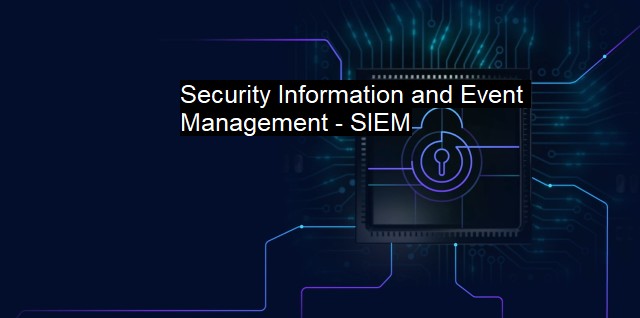What is Security Information and Event Management - SIEM?
The Crucial Role of Security Information & Event Management (SIEM) in a Comprehensive Cybersecurity Strategy
Security Information and Event Management (SIEM) is an approach to security management incorporating two primary components: Security Information Management (SIM) and Security Event Management (SEM). This strategic cybersecurity tool has become highly crucial for businesses to ensure security, compliance, and efficient operation in today's digitally driven era.SIEM encompasses solutions designed to collect and merge data from various sources, identify deviations and aspects suspicious of a security breach or a potential one. it offers deep insights and understanding into security-related incidents within an IT environment.
The primary features of SIEM software are its abilities to aggregate relevant data from multiple sources, identify deviations from the norm, and initiate appropriate actions. Serving as a single aggregation point for log information from various systems, devices, and applications in a network aids an organization in saving on time and resources otherwise spent in manually collecting log data.
SIM is a comprehensive component of SIEM that deals with the long-term storage, analysis, and reporting of log data. When an event sequence is identified by SIM, it marks these incidents to resolve any security-related issues. On the other hand, SEM administers real-time monitoring, event correlation, and console viewing, hence providing a consolidated view of system events to act promptly during a security incident.
The real-time analytics feature of SIEM provides businesses with an ability to detect unusual activities or trends that might result from a security breach. Irrespective of the degree of breach, whether simple or advanced, SIEM ensures prompt alerts are sent to the respective security personnel, enabling speedy response to the threat detected.
One of the distinctive advantages of deploying a SIEM is its advanced correlation capabilities. Even when systems and applications create billions of events, the automated rule-set of SIEM can help identify and connect varying events from various sources leading to a security incident. This ability to correlate related events into manageable clusters becomes of paramount importance in high traffic environments it simplifies complex data sets.
SIEM provides dashboards, visualization, and other handy tools for effective cybersecurity management. Depending on the specific needs of the organization, custom dashboards may be configured to display different types of relevant security data. SIEM solutions also provide users with reports geared towards compliance requirements to aid organizations to streamline their preparation for audits.
The increasing number of data breaches and the need to abide by regulatory compliance is driving businesses to reassess their current security setup. An SIEM technology not only addresses these issues but also improves the efficiency of the incident handling process.
SIEM can seamlessly integrate with antivirus software, ensuring a more proactive approach to network security. For instance, if ransomware is detected on a device, the antivirus software neutralizes it and sends an alert about this security event to the central SIEM system. The incident is then recorded, aggregated with other log data, inspected for patterns, and used to enhance future threat detection.
Like any solution, SIEM isn't a silver bullet for every security scenario. While it can collect, correlate and analyse network data significantly, recognising and responding to threats is still dependent on competent security experts who can interpret the findings effectively. Therefore, it should not be considered a replacement for a strong security team, but more a vital tool in their armoury.
SIEM integrates a wide spectrum of functionality offering superior threat detection, increased visibility across the enterprise, decreased response times and compliance to regulations. Therefore, SIEM exists as an influential technology which anticipates, identifies and manages potential threats augmenting the overall integrity of the information systems.

Security Information and Event Management - SIEM FAQs
What is SIEM?
SIEM stands for Security Information and Event Management. It is a cybersecurity solution that collects, analyzes, and correlates data from various sources to identify and respond to security threats in near real-time.What are the benefits of SIEM?
The benefits of SIEM include enhanced threat detection and response, increased visibility into security events across the organization, improved compliance reporting, and more efficient use of security resources.What data sources does SIEM collect and analyze?
SIEM can collect and analyze data from a variety of sources, including network logs, system logs, endpoint data, application logs, and security devices such as firewalls and antivirus software.Is SIEM effective against antivirus threats?
SIEM can complement antivirus software by detecting and responding to threats that antivirus software may miss. For example, SIEM can identify suspicious network traffic patterns or abnormal user behavior that may indicate a malware infection or other security breach. However, SIEM is not a replacement for antivirus software and should be used in conjunction with other cybersecurity solutions for optimal protection.| | A | | | B | | | C | | | D | | | E | | | F | | | G | | | H | | | I | | | J | | | K | | | L | | | M | |
| | N | | | O | | | P | | | Q | | | R | | | S | | | T | | | U | | | V | | | W | | | X | | | Y | | | Z | |
| | 1 | | | 2 | | | 3 | | | 4 | | | 7 | | | 8 | | |||||||